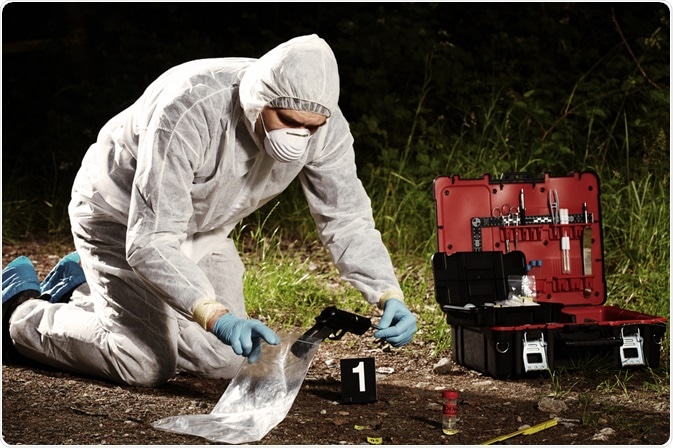Advancements in forensic technologies, particularly DNA sequencing technology, have led to a drastic increase in sensitivity. This means that very small amounts of DNA are now detectable. Although this is an advantage, it also means that small amounts of DNA contamination are likely to be detected. Contamination can have a significant impact on forensic investigations, therefore it is integral that steps are taken to reduce contamination at every step.

Crime Scene Investigator. Image Credit: Couperfield/Shutterstock.com
The Forensic Science Regulator Guidance defines contamination as ‘the introduction of DNA, or biological material containing DNA, to an exhibit at or after the point when a controlled forensic process starts’. This makes a clear distinction between contamination, and background DNA that may be unrelated to the investigation but deposited before it takes place.
Contamination poses two primary issues to forensic investigations: firstly, contamination may link an innocent individual to a crime and secondly, a contaminated crime scene may render true evidence inadmissible and lead to a guilty individual not being charged. Any physical contact has the potential to result in the transfer of DNA, for example through skin cells, hair, or saliva.
Although DNA sequencing technology has been subject to significant advancements, the handling of evidence has not meaningfully changed to match this. It is therefore incredibly important that care is taken in forensic investigations to minimize contact with evidence as much as possible, and that strict protocols are both in place and properly followed.
How does contamination occur?
There are two distinct phases of a forensic investigation during which contamination can occur. The first is during the investigation of a scene, and the second is during laboratory analysis. Contamination of an exhibit can occur in several ways, for example directly from an individual, from the gloves of an individual, from contaminated equipment or consumables, or from one exhibit to another.
To illustrate this, when a person touches an object, they may not only deposit their own DNA but also pick up and transfer the DNA of another person. If a crime scene investigator handles multiple objects, they risk transferring DNA from one object to another. This is also a risk when dusting for fingerprints, as if the same brush and powder are used across several surfaces, they may pick up and transfer DNA. Likewise, if an evidence bag is contaminated during the manufacturing process, this may result in trace DNA in the bag being attributed to the exhibit.
How is contamination reduced?
Detecting and removing contamination after the fact is a difficult process. One of the primary methods of detecting contamination is through the maintenance of databases containing the DNA profiles of any individual with a high risk of producing contamination. Although this helps to identify contamination, reducing contamination in the first instance is still preferential.
Several steps should be taken to reduce contamination, for example: minimizing direct contact with exhibits through barrier clothing, minimizing the number of people who have contact with exhibits, cleaning and/or sterilizing any equipment between uses, and testing equipment and consumables for contamination prior to use.
The Forensic Science Regulator Guidance states that for each serious scene, a forensic strategy should be written up, containing a thorough anti-contamination strategy specific to that scene. This should consider ways to minimize contamination from staff, minimizing the number of staff working on other scenes to prevent the transfer from one to another, and control of the scene to prevent access for other individuals.
Barrier clothing to prevent direct contact between individuals working on a scene and the exhibits is one of the most important steps in reducing contamination. The clothing required at crime scenes can include a face mask, hair cover, two pairs of gloves, an over-suit, and overshoes.
Face masks and gloves can be considered the most important items of barrier clothing, as the mouth and hands and the biggest sources of contamination. Similarly, protective clothing must also be worn in the laboratory. This typically consists of a laboratory coat covering the neck, arms, and wrists, two pairs of gloves, a face mask, and a hair cover.
Conclusion
As DNA sequencing technologies used in forensic investigations have drastically advanced and increased in sensitivity, the likelihood of detecting DNA contamination has also increased. There are significant risks associated with contamination of important evidence and as such, it is necessary to highlight the importance of minimizing contamination. Although the laboratory environment has long been aware of the risks of contamination, this has not always been paralleled at the scene to be investigated.
Regulatory bodies such as the Forensic Science Regulator have developed guidelines to control and minimize the risk of contamination during a forensic investigation. Although contamination can often not be entirely eliminated, careful adherence to these guidelines is integral to ensure that a high-quality investigation can be performed.
Sources:
- Balk, C. (2015). Reducing Contamination in Forensic Science. Themis: Research Journal of Justice Studies and Forensic Science. 3(12). Doi: https://doi.org/10.31979/THEMIS.2015.0312
- Forensic Science Regulator (2020). Forensic Science Regulator Guidance: The Control and Avoidance of Contamination in Scene Examination involving DNA Evidence Recovery FSR-G-206. Crown Copyright. Available at: assets.publishing.service.gov.uk/.../FSR_G-206_Issue_2_Final.pdf [Accessed: 01 June 2021]
- Fonnelop, AE., Johannessen, H., Egeland, T., Gill, P. (2016). Contamination during criminal investigation: Detecting police contamination and secondary DNA transfer from evidence bags. Forensic Science International: Genetics. 23, 121-129. Doi: 10.1016/j.fsigen.2016.04.003
Further Reading
Last Updated: Aug 11, 2021